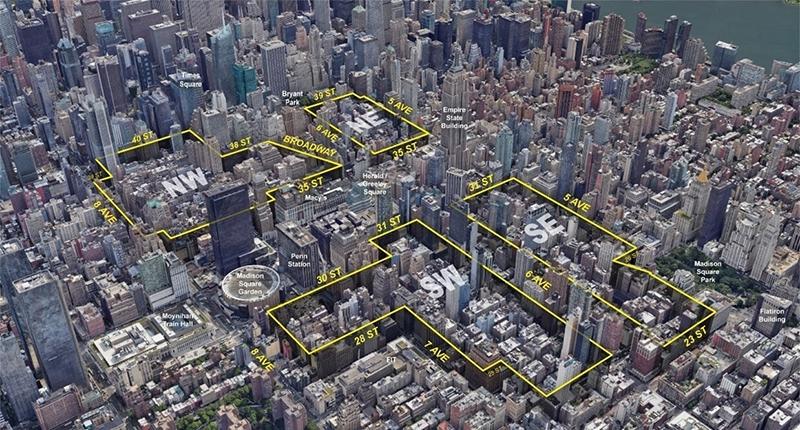By Contributor,Penn Station,Shimon Shkury
Copyright forbes

The Midtown South Mixed-Use (MSMX) Plan spans four distinct quadrants—roughly between 23rd and 40th Streets and Fifth and Eighth Avenues—and is expected to create nearly 10,000 new homes, of which close to 3,000 will be permanently affordable.
NYC Department of City Planning
New York City officials have approved a sweeping rezoning of 42 blocks in Midtown Manhattan, replacing outdated manufacturing zoning with residential to foster a vibrant, 24/7 mixed-use district.
The Midtown South Mixed-Use (MSMX) Plan spans four distinct quadrants—roughly between West 23rd and West 40th Streets and Fifth and Eighth Avenues—and is expected to create nearly 10,000 new homes, of which close to 3,000 will be permanently affordable.
The initiative is one of five rezoning projects plus the City of Yes for Housing Opportunity that the Adams administration has undertaken to address New York City’s housing crisis. The city’s vacancy rate is at a historic low of 1.4% and officials estimate that about 500,000 new units of housing will be needed by 2032.
Rezoning and Incentives Poised to Unlock Office-to-Residential Conversions
Howard Raber, Director, Investment Sales at Ariel Property Advisors, said that owners and developers are tremendously optimistic about the Midtown South rezoning plan because it will allow both office-to-residential conversions and ground-up residential developments.
Office-to-residential conversions will be facilitated by the 467-m tax abatement, which was introduced in New York State’s 2025 Budget. To qualify for the tax exemption, at least 25% of the units must be rented at a weighted average of 80% of Area Median Income (AMI) through the Mandatory Inclusionary Housing (MIH) program.
MORE FOR YOU
In Manhattan (below 96th Street) the tax savings will be 90% of the tax bill, whereas outside of this area the tax savings will be 65% of the tax bill. The length of the tax exemption is determined by commencement date:
Projects that commence before July 1, 2026: 35-year benefit
Projects that commence before July 1, 2028: 30-year benefit
Projects that commence before July 1, 2031: 25-year benefit
Raber noted that Ariel is arranging financing for a client acquiring a vacant office property in the rezoned area that will be converted to 110 residential rental units in a mixed-use building using the 467-m tax abatement. Such office-to-residential conversions are desirable because residential rents in a converted building could be double or triple the rent generated in a Class C office building, he said.
Assemblages and Higher Density Caps Will Allow Larger Residential Developments
“There also is significant potential for assemblages, where multiple older, obsolete office buildings can be combined to create new development sites, leveraging air rights to build much-needed housing and transform blocks with higher rental values compared to vacant or low-rent office spaces,” Raber said.
The Adams administration lobbied the New York State Legislature to lift the floor-to-area ratio (FAR) cap in the 2025 State Budget, which enabled the City of Yes to create higher density R11 and R12 zoning districts in Midtown South. This change will allow FARs of 15 and 18 for new residential projects with Mandatory Inclusionary Housing, thereby creating more affordable housing. Many office buildings in the area already have FARs higher than 15 or 18. Additionally, developers of ground-up projects can avail themselves of the 485-x tax incentive for rental buildings, which also was part of the State’s 2025 Budget.
Raber further explained that the Mandatory Inclusionary Housing requirement will most likely push developers to focus on rental projects in the rezoned area. He predicts this will lower development site prices to under $300 per buildable square foot (BSF), making properties more affordable for builders. While condo developments could be an option, such projects would still need to comply with the Mandatory Inclusionary Housing requirements and other regulations, which would also result in lower pricing. Notwithstanding the lower per-foot values, owners may still benefit from the overall increase in buildable square footage, which can translate into higher total sale prices for development sites.
The Adams administration’s Midtown South Mixed-Use (MSMX) Plan will revitalize outdated zoning rules throughout Midtown to create nearly 10,000 new homes, including nearly 3,000 permanently affordable units.
NYC Department of City Planning
Owners Embrace Midtown South Zoning Plan
Within the Midtown South rezoning area, about 40 million square feet is situated in the Garment District, said Barbara Blair, President of the Garment District Alliance, a business improvement district that works in partnership with local building owners and businesses to improve the quality of life and economic vitality of the neighborhood.
Blair said that property owners in the Garment District have advocated for residential zoning for decades. They have embraced the Midtown South Mixed-Use (MSMX) Plan because it presents the opportunity to either convert buildings or construct new residential developments.
“The District has a lot of five-story, 25-foot wide buildings that would make ideal assemblages suitable for a ground-up development, while others would make fantastic loft apartments,” Blair said.
New residential developments will change the nature of the district and, when combined with the 54 existing hotels, create a 24/7 live/work environment that will bring in better amenities and retail to the neighborhood, Blair said.
She emphasized that the Garment District is ideally located in the center of Manhattan, a short walk to Manhattan’s restaurants and arts and cultural institutions. Anchored by Penn Station and the Port Authority Bus Terminal, the neighborhood also serves as a major transit hub with unmatched access to the entire region, country and all local airports.
Decline in Manufacturing Jobs, Housing Crisis Prompted City to Approve New Zoning
Blair noted that the once dominant fashion industry has seen manufacturing jobs in the Garment District fall by 93% since 1987. In 2016, there were between 4,500 and 5,000 jobs in apparel manufacturing and that number has fallen to about 2,700 today. A zoning overlay aimed at preserving space for apparel manufacturing was approved in 1987 but was ineffective in saving jobs. Consequently, in 2018 the City allowed building owners to legally lease space to non-fashion tenants. Before Covid, the neighborhood had about 146,000 jobs, of which only 2% were in the apparel sector.
This map shows that south of 40th Street, 37 buildings representing about 4 million square feet and several blocks along Eighth Avenue were excluded from the rezoning shortly before the City Council vote.
Belkin • Burden • Goldman, LLP
At the behest of the fashion industry, however, 37 buildings representing 4 million square feet and several blocks along Eighth Avenue were excluded from the rezoning shortly before the City Council vote.
Blair lamented that buildings along Eighth Avenue were excluded from the rezoning because it will jeopardize creating a grand entrance between Penn Station at 34th Street and Port Authority at 42nd Street, both of which are being redeveloped.
An increased residential population would bring a crucial stakeholder group to the neighborhood, she said, providing pushback against the over-saturation of social services and fostering a more diverse and vibrant street presence beyond just daytime workers. Five harm reduction facilities and 16 shelters are currently located along Eighth Avenue.
In addition to improvements to Eighth Avenue, Blair would like to see a pedestrian corridor along 37th Street west of Eighth Avenue that would cater to visitors coming to and from the Jacob Javits Center on 11th Avenue between 34th Street and 38th Street.
“We’re thinking about how to integrate this neighborhood with the central business district and reconnect it to the rest of Manhattan,” she said.
The Port Authority of New York and New Jersey announced in January 2025 federal approval of a $1.9 billion loan through the U.S. Department of Transportation toward the construction of the first phase of the Midtown Bus Terminal replacement project.
Port Authority of NY NJ
Midtown South Rezoning is One of Five Citywide Zoning Initiatives
Besides the Midtown South Rezoning and City of Yes, the Adams administration has introduced and received approval for two other rezonings that will create new housing—the Atlantic Avenue Mixed-Use Plan and the Bronx Metro-North Rezoning. The administration estimates these initiatives will create an estimated 100,000 new homes. Two additional rezonings in Long Island City and Jamaica, Queens, are in the pipeline.
More information about the Midtown South Rezoning Plan is available on this Coffee & Cap Rates Podcast.
Ariel Property Advisors
Editorial StandardsReprints & Permissions



